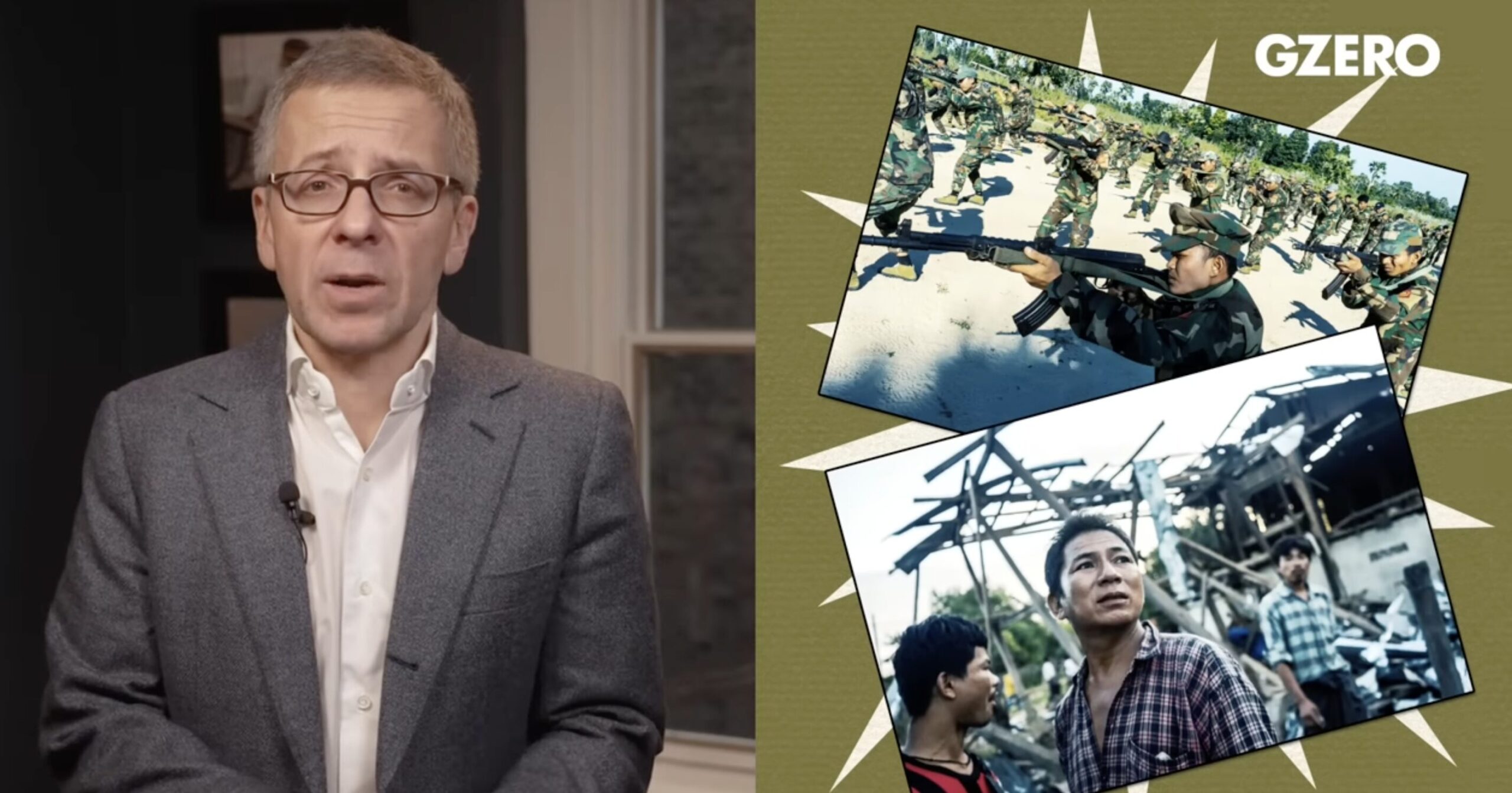
Peter Zeihan: Europe Goes Nuclear
We’ve got two major developments in Eurasia. We’re talking about Ukraine disabling two ships in the Caspian Sea and Poland getting EU approval to build…
Thought Leader: Peter Zeihan

Just after dark on December 27, 2019, more than 30 rockets rained down on a military installation in Iraq’s northern city of Kirkuk. Though no group formally took responsibility for the strike, the United States intelligence community had an early suspect in mind: Kata’ib Hezbollah (KH), a well organized and Iran-supported militia operating in Iraq and Syria. According to U.S. assessments, the Shia fighters had carried out at least 10 other high-profile rocket attacks in the region over the course of just two months—all targeting outposts housing American personnel.
But for the first time in the recent uptick in violence, the militia’s incoming rocket fire made a direct and lethal hit, killing Nawres Hamid—an American interpreter and father of two—and injuring four U.S. troops. The attack kicked off a brief but alarming period that moved the U.S., Iran, and Iraqi factions to the brink of war.
Until recently, however, the United States’ very real proximity to another protracted conflict in the Middle East was largely unknown to the public. In a recent tell-all on his time as defense secretary under former President Donald Trump, Mark Esper shed new light on a period of American foreign policymaking reportedly stunted by intra-administration dissent, mired in party polarization, and plagued by failing global alliances. At its heart: an inconsistent and often openly combative commander in chief whose decisions had clear implications on U.S. policy toward Iran and Afghanistan.
In the administration’s dealings with Iran, Esper explained, this inconsistency yielded an ever more confrontational relationship with the sitting Islamic Republic regime. In Afghanistan, on the other hand, Trump’s conciliatory approach to Taliban leadership emboldened the terrorist group and led to a half-hearted peace process. Washington’s ability to deal with both adversaries suffered for want of a coherent strategy, according to Esper.
The months between the fall of 2019 and the spring of 2020 marked a period of great uncertainty in the foreign policy community. In the days following KH’s attack in late December 2019, Esper, Secretary of State Mike Pompeo, National Security Adviser Robert O’Brien, Joint Chiefs of Staff Chairman Gen. Mark Milley, and other senior administration officials scrambled to unify behind a retaliatory response. The group ultimately settled on a series of airstrikes targeting arms caches and command centers belonging to the militia, killing about two dozen of its fighters in the process.
From an operational standpoint, the strikes were a success. But according to Esper’s newly published account, the Pentagon’s decision not to target members of Iran’s Islamic Revolutionary Guards Corps (IRGC) in an effort to avoid an unnecessary escalation “really angered Trump.” During an impromptu meeting, held at Trump’s Mar-a-Lago resort, the administration’s leading foreign policy and military minds formulated a contingency plan to kill Quds Force commander Qassem Suleimani if Iran chose to escalate further.
For his part, Esper—with the support of Milley—reportedly pushed the president to consider lesser targets. Suleimani’s hold over the IRGC elevated him to perhaps the second-most powerful leadership position in Iran, behind Supreme Leader Ali Khamenei. But Suleimani’s command of paramilitary groups abroad, particularly in Iraq, made him a compelling target for the White House. The Pentagon estimated that the general had been responsible for the deaths of roughly 600 U.S. military personnel.
In a review copy of Esper’s book—which was heavily censored by the Defense Department before legal action helped clear the “overwhelming majority” of its content—passages containing redactions indicated that Israel had also pushed for the U.S. military to target Suleimani. The sections lend credence to statements by a former Israeli intelligence official last year confirming Jerusalem’s involvement in a U.S. strike in Baghdad that eventually killed the commander.
Another of Esper’s partially redacted recollections alleged that former Israeli Prime Minister Benjamin Netanyahu often pushed for preemptive military strikes on Iran’s nuclear program.
It’s unclear whether Trump fully supported such a move. In some instances, Esper explained, the president went so far as to abandon planned missions altogether to keep the peace with foreign adversaries. In others, like in the case of his proposed hit on Suleimani, the president pushed for some of the most extreme options at the U.S. military’s disposal.
“This was one of the mysteries of Donald Trump as commander in chief. Sometimes he would express concern about being drawn into a conflict, and he was always talking about getting out of the ‘endless wars,’” Esper wrote. “At other times … he would complain we were not being tough enough and want the most aggressive options possible. His views on the use of force swung back and forth like a pendulum, though even a pendulum has some predictability. The president rarely gave us much at all.”
But faced with a growing body of intelligence indicating that Suleimani was planning a large-scale attack on U.S. targets across the Middle East, Esper ultimately endorsed the drone strike that killed the Iranian commander—along with his Iraqi ally and KH leader, Abu Mahdi al-Muhandis—in the early days of 2020. In response, Iran launched 16 ballistic missiles at U.S. personnel housed in two Iraqi military bases, 11 of which made landfall at Al Asad air base.
Though initial reports from the ground indicated that the American side hadn’t sustained any deaths or injuries, the Pentagon later discovered that more than 100 U.S. troops suffered an invisible and thereby under-diagnosed “traumatic brain injury” as a result of the attack. Esper recalled privately encouraging Trump to take their affliction seriously after his public statements downplayed its severity, to which the president reportedly responded: “What about the soldiers in World War II? They didn’t have these brain injuries; they didn’t complain about headaches.”
While the injuries were significant, they could have been much worse. According to Esper, then-CENTCOM commander Gen. Kenneth F. McKenzie Jr.—who had responsibility over U.S. military operations in the Middle East—moved quickly to relocate military equipment and Americans stationed at Al Asad ahead of the Iranian missile barrage, ultimately saving an estimated “100 to 150 personnel and 20 to 30 aircraft” from destruction. The strikes ultimately led to the U.S. deployment of Patriot air defense systems to Iraq and temporary de-escalation with Tehran.
Meanwhile, in Afghanistan, the Trump team was taking a very different approach. After surging the number of U.S. troops in the country to 14,000 on the advice of former Defense Secretary Jim Mattis, Esper wrote, Trump grew determined to slash the U.S. presence in Afghanistan to zero or near-zero before the 2020 election—regardless of the cost. In a chapter that reveals the deep policy divides between the Pentagon, State Department, and National Security Council (NSC), Esper detailed the grueling process of striking a diplomatic agreement with the Taliban.
Then-National Security Adviser John Bolton and the Defense Department’s undersecretary for policy, John Rood, were among the negotiations’ major critics. In one instance, Bolton reportedly claimed that the State Department had attempted to “cut the NSC out of the process”—something that Esper acknowledged as distinctly possible given the administration’s penchant for leaks.
Among Bolton and Rood’s major objections to the working deal were things that have largely come to pass since the Doha agreement’s finalization in 2020: its lack of enforcement mechanisms with the reduction of a U.S. military presence, its reliance on the Taliban to relinquish ties with terrorist groups like al-Qaeda, and its elimination of the U.S.’s capability to conduct counterterrorism strikes in Afghanistan.
In one of the book’s more shocking accounts, Esper recalled Trump’s proposal to invite Taliban leadership to Washington. Plans were reportedly underway to host the Taliban at Camp David until a car bomb in Kabul killed an American soldier and 11 others, derailing the process and sparing Esper a difficult conversation with the president. “There was no way [Joint Chiefs of Staff Chairman Joseph] Dunford and I could join him,” Esper wrote. “The Taliban had killed and wounded more than twenty thousand U.S. service members in Afghanistan since 2001, and that’s just counting the physical wounds of war.”
But despite the attack, Trump remained steadfast in his effort to rapidly reduce the U.S. military presence in Afghanistan. According to Esper, domestic political considerations—rather than strategic realities on the ground or the Taliban’s adherence (or lack thereof) to the peace process—guided Trump’s decision-making on the Central Asian country.
“Not surprisingly, as 2019 rolled into 2020, and November 3 neared, getting all (or at least most) of our forces out of Afghanistan sooner rather than later became Trump’s singular focus, not implementing the peace agreement. This was obvious to everyone, including the Taliban, I bet,” Esper wrote. “As such, his words and decisions would squander our leverage with them and undermine the prospects for achieving an enduring peace in Afghanistan that would benefit the Afghan people and better safeguard America’s long-term security.”
Peter Zeihan: Europe Goes Nuclear
We’ve got two major developments in Eurasia. We’re talking about Ukraine disabling two ships in the Caspian Sea and Poland getting EU approval to build…
Thought Leader: Peter Zeihan
Dr. Sanjay Gupta’s Top Health Stories of 2025
From the resurgence of measles to a new way to treat pain, 2025 was a challenge for public health while still offering moments of hope. Sanjay…
Thought Leader: Sanjay Gupta
Ian Bremmer: The state of global conflict in 2025
On GZERO World, Ian Bremmer takes a hard look at the biggest global crises and conflicts that defined our world in 2025 with CNN’s Clarissa…
Thought Leader: Ian Bremmer

